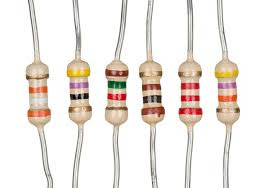Resistors :
A resistor is a component that resists the flow of current. It’s one of the most basic components used in electronic circuits. If you put resistors next to a penny, you get an idea of how small they are.
 |
| Resistors |
Resistors come in a variety of resistance values (how much they resist current, measured in units called ohms and designated by the symbol Ωand power ratings (how much power they can handle without burning up, measured in watts).
Capacitors :
Next to resistors, capacitors are probably the second most commonly used component in electronic circuits. A capacitor is a device that can temporarily store an electric charge.
 |
| Capacitors |
Capacitors come in several different varieties, the two most common being ceramic disk and electrolytic. The amount of capacitance of a given capacitor is usually measured in microfarads, abbreviated μF.
Diodes :
 |
| Diode |
A diode is a device that lets current flow in only one direction. A diode has two terminals, called the anode and the cathode. Current will flow through the diode only when positive voltage is applied to the anode and negative voltage to the cathode. If these voltages are reversed, current will not flow.
Light-Emitting Diodes :
 |
| LED |
Transistor :
A transistor is a three-terminal device in which a voltage applied to one of the terminals (called the base) can control current that flows across the other two terminals (called the collector and the emitter). The transistor is one of the most important devices in electronics.
Integrated Circuits :
 |
| IC |
An integrated circuit is a special component that contains an entire electronic circuit, complete with transistors, diodes, and other elements, all photographically etched onto a tiny piece of silicon. Integrated circuits are the building blocks of modern electronic devices such as computers and cellphones.

Comments
Post a Comment
Do not enter any spam link in the comment box.